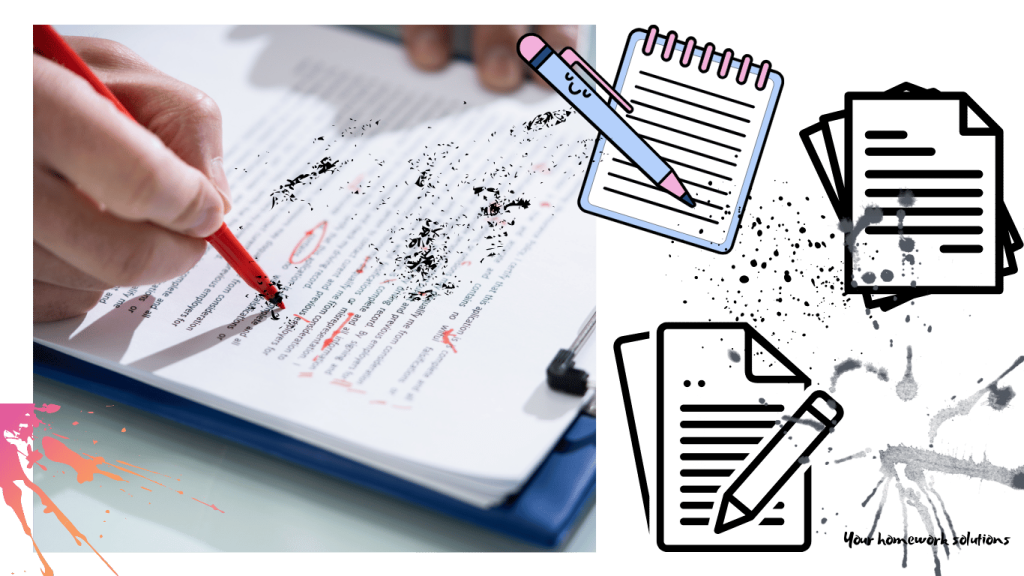Writing assignments is a crucial part of academic success. However, many students struggle with structuring their work, staying on topic, and following guidelines. In this blog post, we’ll share 10 essential tips for writing good assignments to help students achieve better grades and improve their writing skills.
1. Understand the Assignment Requirements
Before you start writing, read the assignment instructions carefully and analyze what is expected of you. Pay close attention to:
- The topic or question – Understand what you need to address and whether it requires critical analysis, argumentation, or explanation.
- The required word count – Stay within the limits, as exceeding or falling short can affect your grade.
- The formatting and citation style – Follow the required style (APA, MLA, Harvard, etc.) for consistency and academic credibility.
- Any specific guidelines or instructions from your professor – Pay attention to any additional instructions regarding structure, tone, or sources.
- The deadline – Manage your time effectively to avoid last-minute rush and ensure quality work.
By fully understanding these details, you can ensure that your assignment meets expectations and is well-structured from the start.
2. Plan and Research Thoroughly
Good assignments begin with proper planning and research. A well-researched paper not only strengthens your argument but also demonstrates a deep understanding of the subject. Follow these steps:
- Brainstorm ideas – Jot down initial thoughts, keywords, and potential angles to explore.
- Conduct background research – Start with general sources like textbooks before diving into scholarly articles and studies.
- Gather information from credible sources – Use books, peer-reviewed journals, academic databases like JSTOR, and reliable websites.
- Take detailed notes – Summarize key points, highlight important quotes, and record bibliographic details for citations.
- Evaluate sources critically – Ensure sources are reputable, up-to-date, and relevant to your topic.
- Create an outline – Organize your research into a structured plan with a logical flow, separating ideas into introduction, body paragraphs, and conclusion.
Thorough planning and research set the foundation for a well-structured and compelling assignment.
3. Develop a Strong Thesis Statement
A thesis statement is the central argument or main idea of your assignment. It acts as the foundation of your paper and informs the reader about your position on the topic. A strong thesis should be:
- Clear and concise – Avoid vague or broad statements.
- Specific to your topic – Address the key focus of your paper without unnecessary generalization.
- Debatable – Present a claim that requires evidence and can be argued from multiple perspectives.
- Well-supported – Ensure that your thesis is backed by research, examples, or logical reasoning.
- Placed strategically – Typically, the thesis appears at the end of the introduction to provide a roadmap for the rest of the paper.
A compelling thesis statement not only guides your writing but also keeps your arguments structured and relevant, making your assignment more persuasive and coherent.
4. Use a Clear Structure
Every assignment should have a logical flow. A well-structured assignment ensures clarity and coherence, making it easier for the reader to follow your arguments. Use the standard essay format:
- Introduction – The introduction is the gateway to your assignment and should captivate the reader’s interest. Begin with a hook—an intriguing fact, statistic, or question related to your topic—to engage the audience. Provide background information to set the context and explain why the topic is important. Define any key terms or concepts that are essential to understanding the subject matter. Conclude the introduction with a clear and concise thesis statement that outlines the main argument or purpose of your assignment. The introduction should set the stage for the discussion and give the reader an overview of what to expect, ensuring a smooth transition into the body paragraphs.
- Body Paragraphs – Each paragraph should focus on a single argument or idea, supported by credible evidence, examples, or research. Begin with a topic sentence that introduces the main point of the paragraph. Follow this with supporting details—facts, statistics, or expert opinions—to strengthen your argument. Use examples to illustrate your points clearly and make them more relatable. Ensure a smooth transition between paragraphs to maintain a logical progression and enhance readability. Using linking words like “furthermore,” “however,” and “therefore” can help create cohesion between ideas.
- Conclusion – The conclusion serves as the final impression of your assignment. Start by summarizing your main points, ensuring that the key arguments presented in your paper are restated concisely. Then, restate your thesis in a compelling way, reinforcing its significance and how your arguments have supported it. If applicable, provide a final thought, such as a reflection on the topic, a call to action, or a suggestion for further research. Ensure that the conclusion leaves a lasting impact on the reader without introducing any new arguments or evidence.
Additionally, using subheadings in longer assignments can enhance readability. Break down your work into sections to make it more organized and visually appealing.
A well-structured assignment enhances readability and coherence, making it more engaging for your audience.
5. Write in a Formal and Academic Tone
Academic writing requires a formal and objective tone. This helps maintain credibility and clarity in your work. To achieve a professional writing style, avoid:
- Slang and colloquial expressions – Use precise and academic language instead of informal terms.
- Personal opinions (unless required) – Maintain an unbiased stance and support arguments with evidence rather than personal beliefs.
- Contractions like “don’t” or “can’t” – Write in full forms, such as “do not” and “cannot,” to uphold a scholarly tone.
- Emotional language – Avoid exaggerated or overly expressive terms; stick to neutral and factual descriptions.
- First-person pronouns (unless specified) – Use a third-person perspective to keep the writing formal and impersonal.
Instead, use clear, concise, and professional language to convey your ideas effectively and maintain academic integrity.
6. Support Your Arguments with Evidence
Every claim you make should be backed by strong and credible evidence. Supporting your arguments with reliable data strengthens your work and enhances its persuasiveness. Use the following types of evidence to substantiate your points:
- Facts and statistics – Use numerical data and factual information from verified sources to add credibility to your claims.
- Examples from reputable sources – Draw from well-regarded academic journals, books, and case studies to illustrate your points effectively.
- Quotes from experts – Incorporate opinions and insights from subject matter specialists to reinforce your arguments and provide authoritative perspectives.
- Empirical research and case studies – Referencing real-world research or case studies adds depth and practical relevance to your discussion.
Always cite your sources properly to maintain academic integrity and avoid plagiarism.
7. Follow the Required Citation Style
Different assignments require different referencing styles. Common ones include:
- APA (American Psychological Association) – Used in social sciences.
- MLA (Modern Language Association) – Used in humanities.
- Harvard Referencing – Common in many disciplines.
Make sure you format citations correctly and include a bibliography or reference list.
8. Be Concise and Stay on Topic
Avoid unnecessary details or going off-topic. Staying focused on the main argument ensures clarity and effectiveness in your writing. To achieve this:
- Write in a direct and precise manner – Express ideas succinctly without unnecessary elaboration.
- Remove repetitive or redundant sentences – Avoid rewording the same point multiple times.
- Use transition words to maintain a smooth flow – Words like “therefore,” “however,” and “in contrast” help guide readers logically through your arguments.
- Stay aligned with the thesis statement – Every paragraph should relate back to your central argument or purpose.
- Prioritize relevance – Ensure every point made contributes meaningfully to your discussion.
Being concise improves readability, keeps the reader engaged, and strengthens the overall quality of your assignment.
9. Proofread and Edit Your Work
Never submit your assignment without thorough proofreading and editing. Careful revision helps eliminate errors and improves the overall clarity of your work. Focus on the following aspects:
- Grammar and spelling errors – Use tools like Grammarly to identify and correct mistakes.
- Clarity and coherence – Ensure your ideas are logically structured and easy to understand. ProWritingAid can help analyze readability.
- Proper punctuation and sentence structure – Check for misplaced commas, run-on sentences, and awkward phrasing. Scribbr provides useful grammar checks.
- Word choice and conciseness – Remove redundant words and refine your language for precision and impact.
- Formatting and consistency – Make sure headings, fonts, citations, and spacing adhere to the required guidelines.
Editing tools like Grammarly, Hemingway Editor, or even reading your work aloud can help refine your writing and ensure a polished final submission.
10. Check for Plagiarism
Plagiarism is a serious academic offense that can result in severe consequences, including loss of marks, academic probation, or even expulsion. To ensure originality and maintain academic integrity, follow these essential steps:
- Use plagiarism detection tools – Tools like Turnitin and Copyscape help identify potential instances of plagiarism by comparing your work against a vast database of academic papers, journals, and online sources.
- Paraphrase information effectively – Instead of copying text verbatim, reword information in your own language while preserving the original meaning. Make sure to fully understand the content before paraphrasing.
- Cite all sources properly – Give appropriate credit to authors and researchers by following the required citation style, whether APA, MLA, Harvard, or another format. Tools like Plagscan can assist in checking for proper referencing.
- Include a bibliography or reference list – Ensure all sources used in your research are listed at the end of your assignment to provide full transparency and acknowledge original authors.
- Use quotation marks when necessary – If using an exact phrase from a source, enclose it in quotation marks and cite the author to avoid unintentional plagiarism.
- Understand institutional policies – Many universities have strict plagiarism policies, so familiarize yourself with the guidelines to avoid accidental academic misconduct.
Submitting unique and well-referenced assignments will not only protect you from plagiarism allegations but also showcase your ability to critically engage with and synthesize information from multiple sources.
Conclusion
Writing a good assignment requires careful planning, thorough research, and a keen eye for detail. By implementing these 10 essential tips, students can enhance their writing proficiency, craft well-structured and compelling assignments, and ultimately secure higher grades. These guidelines will help refine academic writing skills and ensure that assignments meet academic standards effectively.
Need professional writing assistance? Visit our website for expert guidance, personalized feedback, and comprehensive academic support!
References
- Purdue OWL (2023). Assignment Writing Guidelines. Available at: https://owl.purdue.edu/
- Harvard Writing Center (2023). Developing a Thesis. Available at: https://writingcenter.fas.harvard.edu/pages/developing-thesis
- MIT Writing and Communication Center (2023). Structuring Essays. Available at: https://writing.mit.edu/
- APA Style (2023). Referencing Guidelines. Available at: https://apastyle.apa.org/
If you need help writing your assignment, we have the best tutors who can help. Please place your order here



